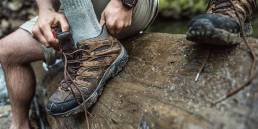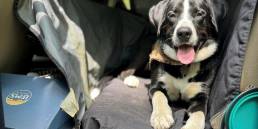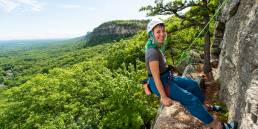“Man looks so small against the universe,” remarked President Ulysses S. Grant as he stood atop Mount Washington in August 1869. He’d just ascended the mountain’s west side via the Cog Railway, and then strolled about the summit, smoking a cigar. Dressed in suits, top hats, and dresses, his party posed for a summit photo—the only inkling of the approaching fall chill was the blankets wrapped around the women’s shoulders. Skinning away from the Marshfield Base Station early on this mid-winter morning, it sure is a lot colder, but President Grant’s 150-year-old remark still rings true: This mountain puts things in perspective. And we have a long way to go.
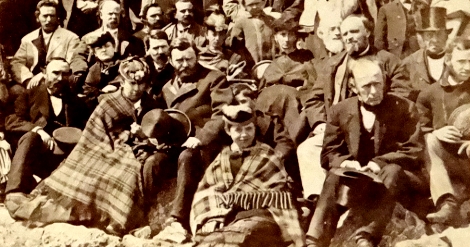
The Cog Railway, which we’ve come to skin and ski today, was the brainchild of New Hampshire native, Slyvester Marsh, who’d made a fortune in Chicago’s meat-packing industry before returning to his home state. After struggling to hike up Mount Washington, Marsh was inspired to build an easier way up the peak. His idea, however, was mocked, with one legislator responding to Marsh’s request for a charter to build the railway with a suggestion that the Legislature instead authorize him to build a railway to the moon. The comment has dogged the Cog for a century and a half; You’ll still hear people call it the “railway to the moon” today.
From the Marshfield Base Station, the Cog, known in Grant’s time as the Sky Railway, ascends up the mountain between Burt and Ammonoosuc Ravines before making a gradual right turn toward the summit. President Grant ascended its 3,600 feet in elevation and roughly three miles in distance in the front of the passenger car. We don’t have that luxury—trains don’t typically run in the winter—and we’re relegated to skinning up the mountain on the open slopes on either side of the track.
His idea, however, was mocked, with one legislator responding to Marsh’s request for a charter to build the railway with a suggestion that the Legislature instead authorize him to build a railway to the moon.

The average grade is 25 percent and drops of perspiration start to appear on our caps shortly into our climb, despite the single-digit temperatures. Still, the first 1,000 feet of elevation go quickly and in no time we’re cruising by Waumbek Tank, a water tank where Grant’s train probably paused to take on more water and coal for the steam-powered engines.
At the time of Grant’s 1869 ascent, the Cog was the world’s first cog-driven railway, employing engines with cog wheels that mesh with a toothed rail in the center of the track for propulsion up and down the steep grade. The track we’re skinning next to this morning is thus the world’s oldest cog railway—running through 28 presidencies since Grant’s.
Near treeline, our skin track shifts out and left of the track as we approach Jacob’s Ladder. A marvel of engineering both in Grant’s era and now, the tracks at Jacob’s Ladder lay at a puckering 37.4 degrees and balance on trestles 30 feet in the air. On his ascent, Grant, sitting at the front of the train, would have been 14 feet higher than those in the rear of the coach. For us, the slope in the vicinity of the Ladder is the crux of the ascent, our skins searching for purchase we climb the steeps near the tracks.
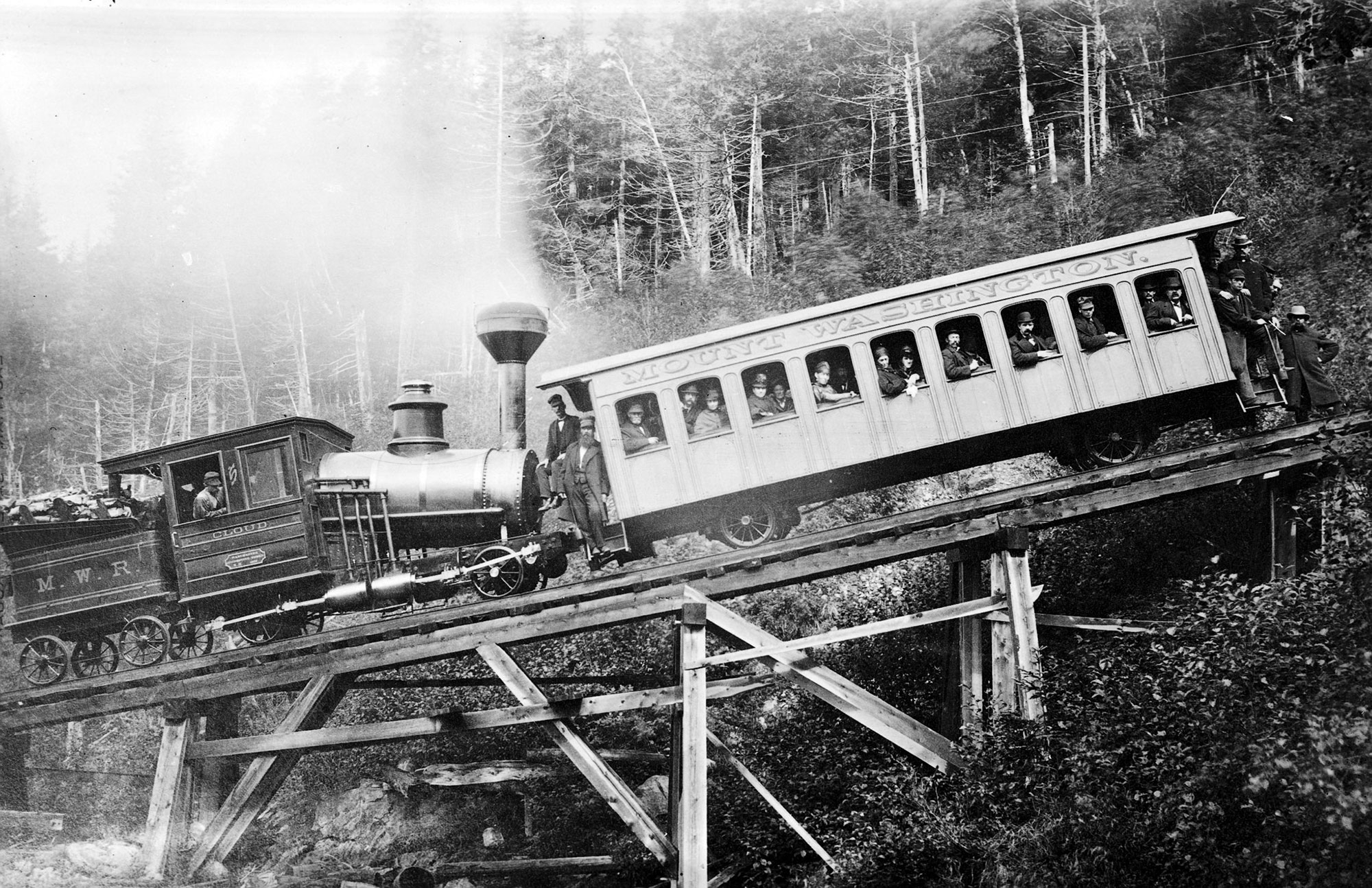
Once above treeline, we continue along the Cog as it bends right, slowing down to take in the view. To the north and south, not much has changed since Grant’s time, with the rugged northern Presidentials running on our left and their gentler southern brethren to our right. Behind us today stands the Mount Washington Hotel—which wouldn’t be built for another 30 years after Grant’s visit—and Bretton Woods, which followed Grant by about a century. Grant would certainly have seen signs of civilization, however; logging and railroads were extremely active in the area and hiking in the Whites, especially on the Crawford Path, was rising in popularity.
On his ascent, Grant, sitting at the front of the train, would have been 14 feet higher than those in the rear of the coach.
Arriving on Mount Washington’s summit, we seek refuge from the wind behind the Sherman Adams Visitor Center and quickly dig out puffy coats, mittens, and balaclavas. Grant’s visit to Mount Washington’s summit predates the Sherman Adams building by about 110 years, but the Summit House hotel would have stood nearby. Our arrival on the peak is not met with the same fanfare as Grant’s. A cannon announced the President’s arrival on the summit and the railway’s founder, Marsh, was there to shake Grant’s hand. Between the cold and the wind, none of the few hardy souls milling about the summit this morning venture over to greet us as we transition for our ski down the mountain.
While Grant was our inspiration to come up the Cog this morning, we’re taking our descent cues from the railway’s early employees. They would descend the Cog on a slide board made of metal and wood. Called a “devil’s shingle,” the board fit into the tracks and riders descended toboggan-like using friction-inducing brake handles to control their speed. With the thin, windblown, and rocky snowpack up high, we won’t match the 60 mph speeds achieved on the contraptions, let alone the 2 minute and 45 second record-fast slide. But it does leave us wondering if this was what P.T. Barnum, another early passenger on the Cog Railway, was referring to when he described the railroad as the “second greatest show on earth.”

As we ski away from the summit and begin sliding downhill, we can only wonder what Grant thought during his descent. Maybe he was thinking back to earlier stops on his trip to New England—Newport, Rhode Island; Boston, Massachusetts; and Manchester and Concord, New Hampshire—or his night before at the Crawford House. Maybe he was thinking ahead to the tour’s next destinations—Littleton, New Hampshire, then off to Saratoga Springs, New York. Or maybe he was doing just what we’re doing now: taking in the serene beauty of the landscape as he cruised down Mount Washington.
Tim Peck and Doug Martland
Tim and Doug met long ago at the Eastern Mountain Sports in Canton, Massachusetts. Bonding over a love of slick Quincy Quarry granite, White Mountain sufferfests, and scheming up adventures while folding tee-shirts, today Tim and Doug collaborate to write about their favorite outdoor activities and occasionally get nostalgic about tee-shirt tables.
Related Posts
April 24, 2024
What to Bring When Road Tripping with Your Dog
Prepare for the ultimate road trip with…


